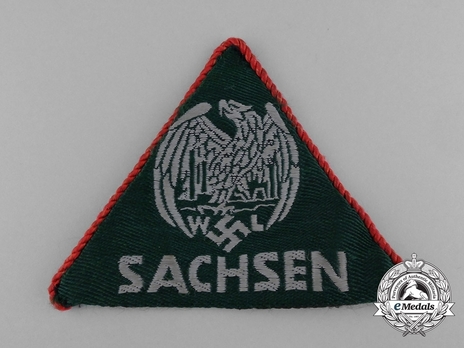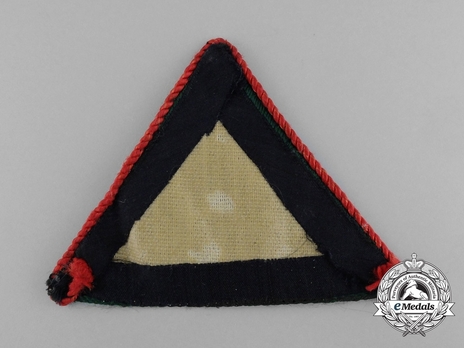WLS Saxony Triangle (red piping)
CATEGORY: Version
SKU: 56.GOR.03.02.04.004.000
Estimated market value:



Estimated market value:
Gray embroidered insignia illustrating a stylized eagle above a swastika, the swastika flanked by "W" at the left and "L" at the right, with gray embroidered text inscribed "SACHSEN" below, on a green embroidered base, the left and right edges trimmed in angled red embroidery, black cloth reinforcing strips stitched in place on all three sides on the reverse, 74 mm x 99 mm, extremely fine. Rare.
Air raid protection organisations existed during the time of the Weimar Republic in the 1920s. However, in preparation for a coming war, a greater need for a centralised organisation under NSDAP control arose. It was established mere months after the NSDAP took control of Germany. The Reichsluftschutzbund (National Air Raid Protection League) or RLB was founded on April 29, 1933 under the control of Hermann Göring as Minister of Aviation. Naturally, its leader, as well as the nature of the organisation’s tasks, meant that the RLB would always have close ties to the Luftwaffe. All previously founded air raid protection organisations ceased to exist or were forcefully absorbed into the RLB.
The RLB’s function was to train the public on how to prepare for and deal with enemy air raids, and act as a supervisor of civil protection and defense, for both private homes and for places of work. Therefore, the RLB’s focus was split up into what was referred to as Selbstschutz (self-defense) for homes and Erweiterter Selbstschutz (extended self-defense) for places of work. Air raid protection of industry that was deemed essential to the war effort was referred to as Werkluftschutz (Factory Air Raid Protection) or WLS.
The core of the organisation was made up of high-ranking Luftwaffe officers (the RLB leader was always a Luftwaffe General) and a number of full-time salaried RLB members. These professional RLB members made up only a minority of the organisation, since the vast majority of members were, in fact, volunteers. Eventually, a law passed on June 26, 1935 made it a legal duty for almost everybody to receive training by the RLB.
In May of 1937, the Sicherheits- und Hilfsdienst (Security and Assistance Service) or SHD was founded. This was meant as a sister organisation of the RLB made up of professionals rather than amateurs, including firefighters, medical personnel, and specialist troops like public utilities repair service, gas decontamination service, or salvage crews.
At the same time, the Luftschutzwarndienst (Air Raid Warning Service) or LSW was founded. It was intended as an intermediary between the Flugmeldedienst (Flight Message Service) and the air raid protection organisations. The Flugmeldedienst was responsible for spotting enemy aircraft and determining their likely targets, so the population could receive a warning before an attack was carried out.
The SHD was split in the spring of 1942, with the Luftwaffe taking control of its mobile (motorised) units, and the Police taking control of its static units under the name of Luftschutzpolizei (Air Raid Defense Police).
The water-related units were formed into a new organisation, the Wasserstraßenluftschutz (Waterways Air Defense) or WSL. This organisation was entirely separate from and not affiliated with the Wasserschutzpolizei, the Water Protection Police. The WSL’s creation was officially announced on June 1, 1942.
The WLS Saxony triangle insignia was introduced in March of 1940. It features a dark green cloth backing with a white WLS eagle emblem. The eagle’s wings are semi-spread around the outline of a factory with tall chimneys, with a swastika underneath and the letters “W” and “L” to the left and right of it, respectively. At the bottom is the inscription “Sachsen” (Saxony).
The insignia was worn on the upper left arm, above any armband that might have been worn. It is possible that other German states and regions had similar sleeve triangles, but so far only Saxony ones have surfaced. Triangles have been found piped in alternating white and red, in red, blue, or silver. The purpose of the different piping colours is unknown.

Comments
Sign in to comment and reply.


Scroll Top